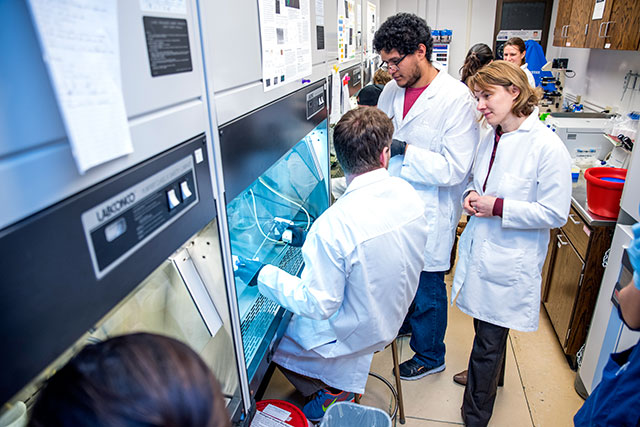HSU biology professors Jacob Varkey and Amy Sprowles are among educators at 12 universities to secure funding from the California Institute for Regenerative Medicine’s Bridges 2.0 Training Program. The award of $3,044,950 will fund stem cell training for HSU students and support up to 10 paid research internships annually for the next five years. Interns are placed in universities with major stem cell research programs. HSU is partnered with labs at UC San Francisco, UC Davis, and Stanford University.

Varkey and Sprowles received their first CIRM Bridges award in 2009. The award funded 70 HSU students who received extensive training in stem cell research at UC Davis, UC San Francisco, and Stanford over a seven-year period.
“The goal of the Bridges program is to prepare undergraduate and master’s level students in California for a successful career in stem cell research,” says Randy Mills, CIRM president and CEO. “That’s not just a matter of giving them money, but also of giving them good mentors who can help train and guide them, of giving them meaningful engagement with patients and patient advocates, so they have a clear vision of the impact the work they are doing can have on people’s lives.”
HSU has a reputation of preparing highly qualified candidates for the CIRM program due, in part, to a rigorous selection process, which includes a complete stem cell training program. “Students enrolled in the courses that make up the training program are prepared to design and conduct experiments that address research questions in the field. This requires instruction in laboratory methods, fundamental scientific principles, and interpretation of the primary literature so they are current in the field of stem cell biology and regenerative medicine,” says Assistant Professor Amy Sprowles, who along with Biology Professor Jacob Varkey, directs HSU’s CIRM Scholars program.
Once students complete the stem cell training program, they are qualified to apply for HSU’s CIRM 12-month paid internship, and to seek a position at one of three host institutions—Stanford University, University of California Davis or University of California San Francisco. “We’ve had students work on everything from brain cancer to spinal cord repair. After their internships, our students have gone on to pursue careers at the top research institutions in the world,” says Sprowles.
In total, 48 students have completed the internship and represent a wide cross section of majors and backgrounds. Chemistry and Biology students study alongside Psychology students, and 35 percent of those are first-generation students. Nearly a quarter self-report as belonging to a demographic that is under-represented in science.
One common trait is success.
“We are very proud of the fact that more than 90 percent of our trainees have found work in the field or have been accepted to highly competitive biomedical graduate or medical professional programs,” says Varkey.
Hannah Collins (‘15, Biology) is 2014-15 CIRM scholar who interned at UC San Francisco. She says CIRM has prepared her to look closely at career opportunities in regenerative medicine and stem cell biology. “CIRM is an opportunity to look into the future. Do you want to be a Ph.D.? Do you want to be in that highly competitive, high-impact world? Do you want to work at a lab bench or do you want to teach? CIRM helps you figure out where you’re going,” says Collins.
Wes Jenkins (‘14, Biology), who currently teaches two sections of the HSU cellular biology laboratory course, also completed the CIRM internship program through UC San Francisco in 2014-15. He credits the program with giving students a deep understanding of science. “You learn fundamental techniques in biology and in regenerative medicine. But more importantly, you get to learn how to think critically—how to design an experiment and how to troubleshoot,” says Jenkins.
The California Institute for Regenerative Medicine was established in 2005 with the passage of Proposition 71, the California Stem Cell Research and Cures Act. To date, the CIRM governing board has approved 253 research and facility grants totaling more than $635 million, making CIRM the world’s largest source of funding for human embryonic stem cell research.
For more information, visit www.cirm.ca.gov.
For more information about the CIRM program at HSU, visit http://www2.humboldt.edu/biosci/hsu-cirm/index.html.